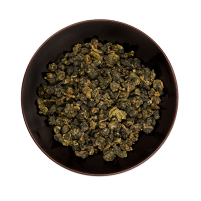This tea is made from the Jin Xuan (literally "Golden Daylily") cultivar known for its remarkable sweetness and creaminess that earned it its Milky Oolong moniker. Developed in Taiwan in the 1980s, this robust and high-yielding crop thrives in temperate climates. At Doi Mae Salong in the very north of Thailand, this oolong is processed in the same centuries-old Taiwanese tradition without the use of aromatic additives.
As typical for oolong, the bud and first three leaves are plucked by hand, which are allowed to grow slightly larger than for green tea. The leaves are then wilted in the sun to remove moisture and kickstart the oxidation/fermentation process, before being alternately withered indoors and outdoors several times. Small tears in the leaves, particularly at the edges, allow cell sap to escape and oxidise with the oxygen in the air.
The leaves are then oxidised more intensively in a fermentation chamber, where they develop a reddish-brown colour at the tear points. Once the desired degree of oxidation is reached, further oxidation is halted by heating the leaves in an oven to denature the enzymes responsible for oxidation in a process known as fixing or "kill green".
Next, the leaves are broken up in a rolling machine, which distributes the aromatic cell sap over the leaves while twisting them, before undergoing a final oven-drying.























